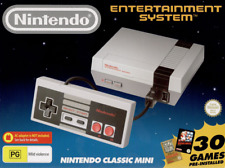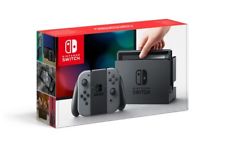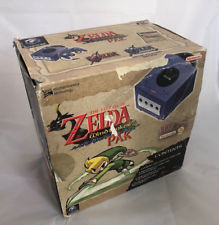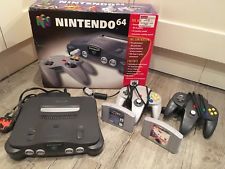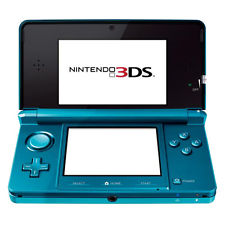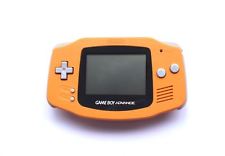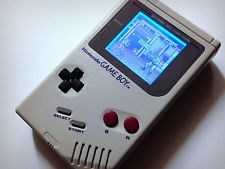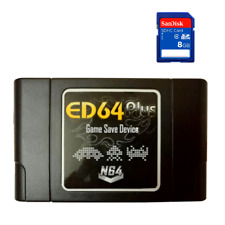|
|
Nintendo DS News is a News and downloads site for All Nintendo Handhelds and Consoles including the Gameboy, NES, N64, Snes, Gamecube, Wii, WiiU, NDS, 3DS, GBA and Snes, We have all the latest emulators, hack, homebrew, commercial games and all the downloads on this site, the latest homebrew and releases, Part of the
DCEmu Homebrew & Gaming Network.
THE LATEST NEWS BELOW
|
September 16th, 2005, 17:41 Posted By: wraggster
Nintendo's head of European marketing sheds more light on next-gen device
16.09.2005 - 15:25
After months of speculation, Nintendo finally revealed their top secret Revolution controller at the Tokyo Game Show today. With its TV remote design and motion-sensing functionality, Nintendo looks set to continue apace on its crusade for making gaming accessible to, well, absolutely anyone and everyone.
We managed to speak to Nintendo's Jim Merrick - the man responsible for the company's European marketing - to find out more about the controller, how it will work and where it fits into Nintendo's master plan...
It would have been nice to actually see some of the games that the controller will be compatible with featured in the video presentation.
We went to great lengths not to show games in the trailer! It's more about keeping the focus on the interface. If you show the game then everybody gets distracted by the graphics and what we really wanted to focus on was the human interface with the game and the machine.
Is the motion-sensing aspect of the controller going to be compatible with all Revolution games?
Like the Nintendo DS, which offers many different input devices such as voice and touch-screen, not every game is going to use every capability of the controller. The Revolution controller can sense not only where you're pointing, but where your relative position front to back, how close you are, whether you're tilting or rolling - it senses all of these things. Those may or may not be appropriate for different games, so there's no absolute requirement that all games should use it.
The current controller design does work reasonably well for certain types of game - we're not going to throw it all out, but we wanted a fresh start and a fresh way of thinking to bring new consumers to the console.
How is movement of the controller detected?
We use Bluetooth technology to communicate between the controller and what we call a 'sensor bar', which has two little sensors on it that are maybe a foot apart. These sensors can be detached from the bar and they can be above the TV or below the TV - it doesn't really matter.
There's really no set-up other than just putting the bar by the TV. There's no calibration for size or type of TV or anything like that.
So presumably the controller will be compatible with all TVs?
It works with any kind of television set - it doesn't matter if it's LCD, plasma, projector or CRT.
And the gamer won't have to sit in the same position every time they're playing a title that uses the motion-sensing function?
Absolutely not - the relative angle in front of the sensor bar is about the same as the viewing angle of the TV. So if you can see the TV, the controller is going to work.
Are the three central buttons on the controller as self-explanatory as they seem?
Well, 'Start' and 'Select' have preconceptions as to what they do - they've been around for years, so that's okay. What exactly the 'Home' button will do, well, we don't really know yet as we've never had one before, so we'll have to see.
How will the controller be powered?
We don't have any specifics on it yet. There are always the pros and cons with the rechargeable batteries, yes they're nice, but then you have to dock it somewhere to charge it up. Disposable batteries are readily available, so… but I don't know, we haven't got there yet.
How will the controllers be bundled with the hardware?
What we call the 'freehand' controller - the basic controller that looks like a remote - and the 'nunchaku-style' controller will be packaged with the hardware and is really an amazing combination.
The third type of controller will be the 'classic-style' expansion controller, which Mr Iwata spoke about in his speech - but there was no visual to go with it because we haven't got the design finalised - we haven't decided how we'll market it.
Can you explain a bit about the classic controller?
It's effectively a shell like a standard controller with a hole in it and you slot in the freehand controller. So for games that are well suited for a traditional style controller, well, there you are.
The classic controller is important for us for our virtual console games. When I'm playing my favourite game - the N64 version of Goldeneye - it's built for that kind of controller.
How do you envisage people using the freehand controller - will it be a true one-handed device given the position of the d-pad and A button?
The problem is that in the past we spent years trying to figure out how to move forward, back and side-to-side using our thumbs. Now, I move the whole controller. If I want to bank my aeroplane - I bank the controller. Suddenly I don't need all the buttons that I needed before to approximate what I want to do - I simply do it. It's much more intuitive. I point just by pointing my hand at the screen. The problem with the analogue is that you're always trying to move it in an analogue fashion, not just slam it up against the edge. This is much more natural.
What can we expect in terms of additional peripherals that will plug into the controller?
We can envision all kinds of possibilities. We were joking the other day that bongo drums for Donkey Konga would've been great with a wireless controller. If you built a set of bongo drums with a slot in it and you just slot in the freehand controller and you're online - that would be great.
When we briefed the guys from Sega they immediately thought of Samba De Amigo. You could have a relatively inexpensive dance mat with a slot in it and you just slot in the freehand controller and you've got a wireless dance mat. So there are all kinds of ways you can go with it.
Will there be any proprietary technology that will eliminate third-party peripheral developers?
We haven't really decided what we're going to do working with third-parties on additional expansion controllers or other things, but it is fair to say that Nintendo will aggressively protect its intellectual property.
Shigeru Miyamoto recently stated that Nintendo was still adding and removing various functions of the controller - can you explain the transitions the device has undergone during development?
We spent a lot of time puzzling over what types of human interface we can do that will be really beneficial to both new gamers and existing gamers, and we've considered all kinds of ideas.
You've seen all the different kinds of technologies that are out there and we needed something that was accurate, reliable and relevant for our audience.
Mr Miyamoto is correct that the design is not 100% final. It is basically complete, but we reserve the right to move buttons and round corners. However, we have not shared everything that there is to know about Revolution or its controller.
So there are still some secrets to be revealed?
C'mon, we're Nintendo - we like to hold things until the very end!
Is this controller a definite statement of Nintendo's intent to broaden gaming horizons for a new audience?
If we can use the DS as an analogy where we have a similar thing happening and a bit of experience, we know that a lot of the consumers who bought 'touch-generation games' - which are really those games designed to reach out to new consumers - we know that those consumers have come back and bought WarioWare and Mario and more traditional games, so they are becoming active gamers again.
What they need is that entry point, but gaming is a bit of an addiction once you get started, you just have to get started. I think they will converge. Certainly there will be games written to address new consumers or written to address all consumers, and at the same time we'll continue to build those games for the existing market, for those core gamers today who got us here in the first place - we can't abandon them. Nintendo is in a unique position in that we've always had the ability to write games for everybody. Zelda, Pokemon, Mario 64 or whatever, we've had the ability to reach the broadest range of people all along, we're just going to expand on that.
Do you think the Revolution is going to distance Nintendo even more from Microsoft and Sony?
We're following our own path, to be sure. We have a different business model than they do, we're not trying to be the centre of your home for the digital distribution of music and movies and things.
We're an entertainment company and we make hardware and software to provide our product, which is entertainment. If that means we go down a different path to our competitors, then so be it. We don't measure our success the same way as they do.
When will we be able to get hands-on with the Revolution and its controller?
I don't know when that's going to be yet. We really want you to experience the games in a complete form and we tend to wait until then.
The example that we have with the DS is that in January 2004 when we first announced it we said it had two screens because that's pretty easy to understand. We didn't say anything about the touch-screen until you could touch it and experience it at E3 and I think we're going to go the same route with Revolution.
We've explained as much as we can and now we need to show you with nearly finished games so that you can really get a sense of the overall experience.
To read more of the post and Download, click here!
 Join In and Discuss Here Join In and Discuss Here
Submit News and Releases Here and Contact Us for Reviews and Advertising Here |
|
 |
|
|
|
September 16th, 2005, 17:34 Posted By: wraggster
And for once it isnt PSP or DS related but its from the Nintendo Revolution Console, the controller has been released to the public and its very different to say the least, heres a looksy:

Check out all the Revolution News at our sister site the top source of pure Nintendo Revolution news ---> The Revolution --> http://revolution.dcemu.co.uk/
Normal Service has now been resumed 
To read more of the post and Download, click here!
 Join In and Discuss Here Join In and Discuss Here
Submit News and Releases Here and Contact Us for Reviews and Advertising Here |
|
 |
|
|
|
September 16th, 2005, 17:33 Posted By: wraggster
And for once it isnt PSP or DS related but its from the Nintendo Revolution Console, the controller has been released to the public and its very different to say the least, heres a looksy:

Check out all the Revolution News at our sister site the top source of pure Nintendo Revolution news ---> The Revolution --> http://revolution.dcemu.co.uk/
Normal Service has now been resumed 
To read more of the post and Download, click here!
 Join In and Discuss Here Join In and Discuss Here
Submit News and Releases Here and Contact Us for Reviews and Advertising Here |
|
 |
|
|
|
September 16th, 2005, 17:26 Posted By: wraggster
Nintendo may have introduced the gaming world to the Revolution at its pre-E3 press conference earlier this year, but it seemed every answer it gave about the system only led to more questions. Where's the controller? How will the backwards compatibility work? When will it launch? Where are the games?
Revolution Now
Witness the unveiling and first demonstration of the unique controller for the Revolution.
When word came that Nintendo president Satoru Iwata was delivering a keynote address at the Tokyo Game Show this year, a show Nintendo traditionally doesn't participate in, conventional wisdom suggested that more answers would be forthcoming.
But perhaps the answers were not as forthcoming as eager gamers would have liked. Iwata took to the stage and delivered his presentation in basically two sections, the first dealing with Nintendo's present and recent past, the second looking toward the future. He began with dry figures, talk of sales, and the success of the Game Boy Micro's Japanese launch.
Then Iwata said Nintendo sees a crisis happening in the industry. He said that making games more complex and photo-realistic has helped the industry grow to the point where it's at today, but such thinking won't keep it growing indefinitely.
"Will anyone invent a new framework that allows for further expansion of the industry or will video game players become bored and cause the industry to shrink," Iwata asked. "We are at this crossroads I believe. For the future of the video game business, we need to expand the market."
Iwata said Nintendo hopes to help the industry through by getting back to the basics and attracting new users. He asserted that if the industry wants to grow, the best way for it to achieve that is through innovation, attracting former gamers back to the fold and finding ways to appeal to the casual and non-gaming crowds.
Iwata specifically pointed out the success of the Famicom Mini Series of classic NES titles on the Game Boy Advance as one initiative that retailers said drew dormant gamers to the cash register. By the same token, the strong sales of the Game Boy Micro and the instant sell-out of the Famicom-styled limited edition of the handheld pointed to the company's ongoing efforts to appeal to that crowd.
As for the casual gaming crowd, Iwata talked about the success of Nintendo's "touch series" games like Nintendogs and "brain exercises" titles, which have been designed to appeal outside the core gamer demographic. He also said the success of such efforts should be taken as a sign that Nintendo knows what it is doing.
After the prelude, Iwata turned his attention to the future, saying it was time to rethink everything about games to make them more accessible for players.
"Since the days of Famicom, the game control mechanism has become more and more sophisticated," Iwata said. "Perhaps those who have quit gaming or who have never played with games looked at the controller and felt it may be too difficult to play, even before they dared to touch the controller."
Following those remarks, Iwata introduced a demo video and the Revolution controller, which sought to rethink the traditional controller concept from the ground up.
The direct pointing device on the front of the controller is intended to make control intuitive for novice players while giving veteran gamers new ways to control their games. Iwata specifically mentioned how the controller could be used for squash, music, or fishing games. He went on to point out that adding the analog controller expansion to the basic controller could drastically change first-person shooters, or perhaps could be used to let someone move their character in a game while the main controller acts as a flashlight the player can shine on the screen.
The controller bears more than a passing resemblance to a TV remote, and that's something Iwata said was definitely intentional.
"To expand the gaming population, it was necessary for us to design the controller so that any family member would like to place it on the living room table and think it was something relevant for them and actually pick it up, just like they do with a TV remote controller."
Not wanting everyone to take his own word for it, Iwata then introduced clips of game developers giving their takes on the Revolution controller, with the concept and execution earning high marks from Final Fantasy XII producer Akitoshi Kawazu, Dragon Quest creator Yuji Horii, and Metal Gear Solid director Hideo Kojima.
"'You've done it!' was my impression," Kojima said. "This was totally unexpected. I was pleasantly surprised because the controller is quite comfortable yet provides something brand new."
Iwata addressed concerns people might have about playing retro games on the Revolution's new controller through its virtual console backwards compatibility, saying that classic-styled expansion controllers would be available so people could enjoy the games as they originally remembered them.
Despite the new technology at work in the Revolution's controller, Iwata insisted that developers would be able to develop cheaply and efficiently for the system. He pointed to small development teams responsible for the brain-training games who created a best-seller despite their use of the DS touchscreen in new ways.
Iwata also stressed the need to offer a greater variety of titles to the market.
"We need to satisfy both the novice gamers looking for simple and compact players and the veteran players who are looking for big, deep highly sophisticated games or we cannot expand the gaming population," Iwata cautioned.
In his closing comments, Iwata expressed confidence that Nintendo is on the right track given trends in the Japanese and foreign markets coupled with the warm public reaction to innovative games like Nintendogs. Don't expect Nintendo to rest on its laurels, as Iwata also emphasized constant innovation as a key for the industry's continued growth.
"When our games can no longer surprise, people will grow tired of gaming."
To read more of the post and Download, click here!
 Join In and Discuss Here Join In and Discuss Here
Submit News and Releases Here and Contact Us for Reviews and Advertising Here |
|
 |
|
|
|
September 16th, 2005, 17:25 Posted By: wraggster
Though the Nintendo Revolution was partially unveiled at this year's Electronic Entertainment Expo, its controller is the final piece of the venerable hardware manufacturer's next-generation puzzle. Speculation about the device has run rampant, because its manufacturer has made a point of keeping it well hidden. Nintendo has chosen only to drop hints that it would be an integral part of the Revolution's unique gameplay experience.
Today, in his keynote address at this year's Tokyo Game Show, Satoru Iwata touched on those themes again, giving further clues about Nintendo's vision for the future, and how the Revolution's controller plays into that future.
Thankfully, GameSpot had the chance to gain a better understanding of what Nintendo is going for with the benefit of a visual and tactile aid--a working prototype of the Revolution controller. Yes, we touched it. Yes, we used it. But is it a "revolution"? It just might be.
Our guided tour of the Revolution controller was led by none other than Shigeru Miyamoto, the industry legend whose talent has been one of the driving forces behind Nintendo's success. But, as always, he was his humble self, emphasizing that the day's presentation was about the possibilities of the controller and not his own upcoming projects. With that disclaimer, Miyamoto and the assembled Nintendo Japan reps unveiled the long-awaited controller, a modest-looking device that is low on flash, but big on functionality.
Miyamoto noted that the impetus for the controller design came from Nintendo's desire to do something "different" after hearing user feedback on consoles. The company felt the current generation of machines was coming close to overwhelming players by taking up too much space in their living rooms and creating briar patches of cables that must be navigated. As a result, Nintendo wanted to offer a solution that starts simple but supports expansion and that offers accessible experiences for casual players and more intricate experiences for hardcore gamers.
The form factor on display wasn't the absolute final design for the Revolution controller, and Nintendo reps noted that it is still a work in progress. That said, it was enough to give us an idea of where the company is headed. The controller itself bears no resemblance to the myriad fan-generated renderings purporting to be the real deal. The unit basically looks like a slim, ergonomic television remote that's about as long as your hand.
As can be seen in the images released today, the controller features core elements along with some you wouldn't expect. A power button at the top left of the unit appears to let you power the Revolution console on or off. An old-school digital D pad rests just below the power button. A large GameCube-controller-style A button is prominently placed below the D pad. Its counterpart B button is located on the opposite side of the remote, like the Z button on the Nintendo 64 controller. Directly below the A button is a series of three buttons: select, home, and start. While it's easy to guess what they do, Nintendo reps offered no details on their exact function.
Below the select, home, and start buttons is another set of vertically aligned buttons labeled X and Y. On some of the prototype controllers we looked at, the X button had a small "B" next to it and the Y button had a small "A" next to it, indicating that the controller can be held sideways to approximate a classic NES controller. Directly beneath those buttons is a horizontal row of colored lights that indicate which controller slot the owner is using--1 to 4 are planned at the moment. The plan is for the controllers to include built-in rumble packs and to run off of batteries, Ă* la the Wavebird for the GameCube.
Finally, the base of the controller features a unique plug that lets you make use of a wide variety of peripherals. One such peripheral is an analog stick attachment with two shoulder buttons labeled Z1 and Z2. Though it gives the combined items an odd, nunchaku-like appearance (which is actually Nintendo's tongue-in-cheek nickname for it), the add-on demonstrates the controller's versatility. The analog stick peripheral will come included with the Revolution hardware, with other attachments to follow in the future. While Miyamoto didn't say much else about what other attachments were in the works, he did note that it's theoretically possible to have entirely different configurations plug into the port--which got us thinking about SNES and N64 controller attachments.
One of the most interesting features of the peripheral is tied to its functionality as a "pointing device." A glossy section of the top of the controller houses a transmitter--much like any remote would have--that was used extensively in the demos we saw. The signal from the unit is picked up by sensors you'll place near your television, which will then reflect your actions on the screen. Based on the responsiveness of the demos that we tried, this feature has the potential to turn the entire base controller unit into a new kind of pointing device. It also has great potential applications for sports games, such as laser-pointer-style play calling.
Overall, despite its unorthodox appearance, the Revolution controller has a comfortable feel. The assorted demos on hand also indicated that playing Revolution games will be a more active, physical experience than playing current-generation games. Whether you're using the pointer mechanic to actively control onscreen action or using two hands to take advantage of attachments, the Revolution controller will likely change how games are played.
Will the change the Revolution heralds be successful? It's too early to say for sure. But given Nintendo's well-documented history of breaking new ground in gaming (such as the DS) we're game to see just how this all pans out. The potential for a revolution is there; Nintendo just has to lead the way with software.
To read more of the post and Download, click here!
 Join In and Discuss Here Join In and Discuss Here
Submit News and Releases Here and Contact Us for Reviews and Advertising Here |
|
 |
|
|
|
September 16th, 2005, 17:24 Posted By: wraggster
Speaking on the first day of the Tokyo Game Show, Nintendo president Satoru Iwata has unveiled the innovative new controller design for the Revolution console - a one-handed device which detects its own location relative to the screen.
The controller is similar in size and design to a television remote control, and sports a trigger button and D-Pad along with a number of action buttons - but the key feature is a sensor which Iwata described as the "Direct Pointing Device".
This sensor allows the Revolution to detect exactly where on the screen the device is being pointed, and also detects the controller's distance from and angle relative to the screen.
An expansion port on the bottom of the controller allows the connection of additional devices, with an analogue stick designed to be held in the other hand being shipped as standard. Iwata described this configuration as "nunchuck style".
Another device which will connect to the expansion port is a more traditionally designed controller, which will allow players to control the Nintendo back catalogue titles which the Revolution can play.
Among the uses for the new controller which were demonstrated by Iwata were a fishing game, a sword fighting title, a multiplayer tennis game and party style games where players could do things ranging from swatting flies to cooking and even performing delicate dental surgery.
Interestingly, Iwata also described the controller as providing a "new standard of gameplay for FPS games", pointing out that it allows a fresh degree of control over shooting and movement in such titles, while another demonstration suggested a survival horror game where the player could "intuitively explore in the dark with a flashlight".
However, no actual software for the device was demonstrated - with the entire presentation showing only videos of players using the controller in a variety of game styles.
"Throughout the history of game development, the game control mechanism has become more and more sophisticated," Iwata explained. "Perhaps those who have quit gaming or who have never played games look at the game controller and think it's too difficult to play, even before they dare to touch it."
"In order to expand the gaming population, it is taken for granted that we need to offer games to satisfy veteran gamers. At the same time, I believe that we need to make a new proposal, so that those who do not play games can say, 'I can do it' and, 'I want to touch it.'"
After presenting the controller to the audience, Iwata went on to explain the company's rationalisation behind making such a radical change to the control scheme which it had originally introduced with the Famicom / NES around 22 years ago.
"Firstly, we face the reality that within one family there are people willing to pick up a game controller, and those who would never touch one," he said. "Anyone will pick up a TV remote control, but not necessarily a game controller. Why is this?"
"We thought it was the requirement of moving right and left fingers separately and nimbly that was creating a psychological barrier," Iwata continued. "To expand the gaming population, it was needed for us to design a pad so that any family member would see it on the living room table, think that this was something relevant to them and pick it up."
"For the controller to be placed on the table at all, we had to make it compact - I believe that this will be possible for this controller. Also, just like a TV remote control, it can be manipulated with one hand."
Iwata continued to discuss the challenges of bringing new gamers into the gaming population throughout his speech, having started out by talking through the recent success of the "TOUCH! Generation" games (including Nintendogs and Brain Training) on Nintendo DS in attracting females and older people into games in Japan.
"The hurdle for non-gamers today must be significantly lowered," he said. "Just as the touch pad did for Nintendo DS, the Revolution controller will enable all users to intuitively play from the same starting line. For all family members, it will be something relevant to them which they are willing to use."
Iwata also presented a select number of Japanese developers to discuss their feelings related to the controller - most notably Konami's Hideo Kojima, creator of the Metal Gear series, who told the audience that his initial reaction to the controller was simply to exclaim, "You've done it!"
"Even though it was a surprise to me at first, I quickly understood how it should be used," he commented. "This is exactly what I was looking for."
Speaking more generally about Revolution, Iwata also touched on Nintendo's pledge to create a platform which will be accessible for smaller developers and those without large budgets.
"On the next generation hardware platforms, the size of the development team is projected to be even bigger, and smaller development studios feel that they can't create games for new platforms," he commented. "With this new interface, teams with limited budgets and people can create innovative software with just their good ideas."
Using the team which created Brain Training on the DS as an example - the title was developed in around four months with a peak team size of just ten people - Iwata argued that Nintendo's new platforms will be an ideal place for small developers to shine.
"Nintendo wants to provide a stage on which to showcase your ideas," he said. "Nintendo is willing to help bring these ideas to life. If seeing the controller today sparks great ideas, Nintendo is waiting for your proposals."
To read more of the post and Download, click here!
 Join In and Discuss Here Join In and Discuss Here
Submit News and Releases Here and Contact Us for Reviews and Advertising Here |
|
 |
|
|
|
September 16th, 2005, 17:23 Posted By: wraggster
Speaking exclusively to GamesIndustry.biz, Nintendo's head of European Developer Business, Marko Hein, has called on the videogames industry to work harder at understanding its markets.
In an interview published today, Hein discusses Nintendo's vision of a market-led development model which individually identifies and targets various niche markets and new emerging demographics, rather than simply building developer-led products.
Referring to the music industry as an example, Hein said that in that market, "they try to investigate who the target group is, what does the market want, and then try to design music for the mass market. I rarely see this in videogames. It's very much developer driven, it's not marketing driven."
"So nobody looks at the market to see which group is currently untouched, which group has a certain potential and then look at how to make a game for this market with research and investigation beforehand," he continued. "Normally a developer comes to you and says 'here's a product, take a look at it'. I'm not sure if we can go on like this in the future."
The interview goes on to cover topics including Nintendo's approach to innovation and its willingness to invest in products which may not have wide commercial appeal, but will help to grow the market for games, such as recent DS title Electroplankton.
"Sometimes you bring a product to market not only for financial reasons, but to open new doors," he commented. "What we are selling with the DS is that the gaming experience is completely different, and we've got a lot of respect for that, even from the competitors."
To read more of the post and Download, click here!
 Join In and Discuss Here Join In and Discuss Here
Submit News and Releases Here and Contact Us for Reviews and Advertising Here |
|
 |
|
|
|
September 16th, 2005, 14:16 Posted By: sci-fisteve
Some renders for what should be the next move for RTS genre by using the twin screens of the DS
A call to all Coders for Demo's which bring this idea to life
To read more of the post and Download, click here!
 Join In and Discuss Here Join In and Discuss Here
Submit News and Releases Here and Contact Us for Reviews and Advertising Here |
|
 |
|
|
|
September 16th, 2005, 08:32 Posted By: wraggster
News from Lik Sang
The entire industry has been clamoring for a taste of Nintendo's so-called next-generation 'revolution.' So have we. Every time Nintendo president Satoru Iwata has opened his mouth, he underscored time and time again Nintendo would not be following the traditional path of a new console. Rumors have persisted for weeks about touch screens, gyroscope functions, virtual headsets, and everything else under the sun.
Today at the Tokyo Game Show, Nintendo finally revealed their big secret to the world. IGN and 1UP.com have seen it, touched it, and played games with it. A site from Norway taped the Nintendo presentation video at TGS. Check out their exthaustive coverage:




To read more of the post and Download, click here!
 Join In and Discuss Here Join In and Discuss Here
Submit News and Releases Here and Contact Us for Reviews and Advertising Here |
|
 |
|
|
|
September 16th, 2005, 01:45 Posted By: wraggster
Source - http://www.drunkencoders.com/
Sgstair posted a quick update on his site:
Some people have been asking what to expect as far as an API goes, and what sort of integration will be required to use this as a library. I've answered this a few times on irc, but I'll put it up here too, for people who want to know:
The API will be purely exposed on ARM9, and will consist of a TCP interface through lwIP (look it up for it's api), a small raw interface to allow sending/receiving raw data, and a custom interface to poll for and connect to access points and other wireless networks.
As far as integration goes, it'll probably require a function to be called on init of arm7 and arm9, a function to be called periodically on arm7 and arm9 (via timer or vblank), and the wifi interrupt will need to be connected on arm7.
As always, this could change, but I'm pretty confident it'll be pretty close.
http://www.akkit.org/dswifi/
To read more of the post and Download, click here!
 Join In and Discuss Here Join In and Discuss Here
Submit News and Releases Here and Contact Us for Reviews and Advertising Here |
|
 |
|
|
|
September 16th, 2005, 01:44 Posted By: wraggster
Upon the release of Kirby: Canvas Curse in Japan, the first copies of the game came with a special pink Kirby stylus. A lot of gamers were upset that the same was not offered outside the country. Well, it looks like things have changed. Nintendo of America is now giving away pink styli, presumably the same ones the Japanese got, to anybody who has registered their copy of Kirby: Canvas Curse on their website.
To get your own stylus you'll have to be a My Nintendo member, which is free. You can sign up for My Nintendo on Nintendo's website. You'll also need to register your copy of Kirby: Canvas Curse, by plugging in the registration code that came with the game on Nintendo's website. Finally, you'll need to visit this page to claim your free pink Kirby stylus. Supplies are limited, so hurry up!
http://www.nintendo.com/stylus_offer/
To read more of the post and Download, click here!
 Join In and Discuss Here Join In and Discuss Here
Submit News and Releases Here and Contact Us for Reviews and Advertising Here |
|
 |
|
|
|
September 16th, 2005, 00:48 Posted By: wraggster
According to the latest issue of Famitsu magazine, Namco will release remakes of Xenosaga Episode I and Episode II on the Nintendo DS as a compilation called Xenosaga I & II.
Like the original releases on the PlayStation 2, the game is being developed by Monolith Soft and published by Namco. Unlike the originals, Xenosaga I & II will play with 2D graphics in an isometric view, with cute characters that resemble the first installment's art style rather than the more realistic look of Episode II. As a compilation, Xenosaga I & II follows along the storyline of the original PlayStation 2 games, but it will also include some new scripts.
Xenosaga I & II's turn-based battle system will be styled after Episode I and will feature the series' "boost" skill, where the player can force a character to move before it's actually his or her turn. Xenosaga I & II will also have a new system tentatively called "P.F.," although details on it haven't been disclosed yet.
Somewhat surprisingly for a DS game, Namco also says that Xenosaga I & II will feature cutscenes, which is one of the elements the Xenosaga series has been known for. Screenshots shared by the magazine show a computer-generated rendering of the Zohar and an anime shot of KOS-MOS.
Just like the recently announced Xenosaga Episode III for the PS2, Xenosaga I & II has not been given a firm release date from Namco yet. However, the game is expected to appear at the Tokyo Game Show this weekend in trailer form, so series fans shouldn't have to wait long to get a look at how the games handle the transfer to 2D.
To read more of the post and Download, click here!
 Join In and Discuss Here Join In and Discuss Here
Submit News and Releases Here and Contact Us for Reviews and Advertising Here |
|
 |
|
|
|
September 15th, 2005, 18:53 Posted By: wraggster
Some WIP news about the Homebrew Star Wars game:
Well I'm working hard on Star Wars DS, but not as much as I'd like...
Anyway some sounds are working for certain events, such as shooting or starting. Collitions are being implemented and finally Ties shoot at you...
It's been a hard work but I'm really looking forward to it... hope you do too.
http://chavads.blogspot.com/
To read more of the post and Download, click here!
 Join In and Discuss Here Join In and Discuss Here
Submit News and Releases Here and Contact Us for Reviews and Advertising Here |
|
 |
|
|
|
September 15th, 2005, 18:50 Posted By: wraggster
Alekmaul is one busy chap, hes now working on a Arcade emu for the Nintendo DS, heres a shot:

Go, a small WIP to announce you that I "make profitable" my Z80 emulator by preparing one... emulator of plays of arcade!
That Ci will contain only sets of arcades with ROMs with format MAME and that those being emulated by Z80 (pacman, pengo, crush roller, etc...).
News and remote loading soon...
Pacman functions already perfectly and at full speed, on emulator as on DS
Keep an eye on his site here http://jmgrd.club.fr/index.php
Get your DS Homebrew Set up quickly 
To read more of the post and Download, click here!
 Join In and Discuss Here Join In and Discuss Here
Submit News and Releases Here and Contact Us for Reviews and Advertising Here |
|
 |
|
|
|
September 15th, 2005, 18:31 Posted By: wraggster
DSemu the Nintendo DS emulator for windows has been updated today, heres whats new:
Support for the X and Y keys have been added. This can be configured using the Options/Configuration menu option. The code for this was contributed by Normmatt.
Many fixes to key handling. Anything but A and B keys were very buggy in previous builds. My 'keys' demo from my tutorials now works correctly and Space Invaders is now playable.
Support for GBA games was re-added. It was removed when I first took up support of DSEmu until I understood the code better. It is now back in and will be maintained.
The FIFO registers have been implemented. This is an important feature for DSLinux and a step towards support for the commercial downloadable demos.
Various bug fixes in graphics code.
The compuational accelerator registers have been implemented. Again, a steps towards support for the commerical downloadable demos. Contributed by Julien Hamaide.
Workaround for 'console scramble'. There has been an issue since DevkitPro R14 which causes text output using the console output routines to be scrambled. I implemented a workaround in 0.4.6 but it didn't work for homebrew programs built with previous versions. I've been unable to fix the problem so far, so I added a 'Unscramble console text' option in the Options/Configuration menu option. If you run a game and the text appears scrambled, check or uncheck this, and it should correct the problem when you press 'Ok'. I hope to fix this in 0.4.8.
Download Here --> http://nintendo-ds.dcemu.co.uk/dsemu.shtml
To read more of the post and Download, click here!
 Join In and Discuss Here Join In and Discuss Here
Submit News and Releases Here and Contact Us for Reviews and Advertising Here |
|
 |
|
|
|
September 15th, 2005, 18:16 Posted By: wraggster
MMC/SD card resurrection We have brought back to life (read: rewritten) the MMC/SD card kernel block device driver. That means that you can now mount and access (read only for now) your MMC/SD cards on your GameCube. Create a block device file if you don't have already one (see source code for majors and minors) and mount your card partitions (mount /dev/sdcardb1 /mnt). As usual, all code is available on CVS (http://cvs.sourceforge.net/viewcvs.py/gc-linux/linux/). In case you are wondering, yes, those 1GB SD cards work 
http://www.gc-linux.org/wiki/Main_Page
To read more of the post and Download, click here!
 Join In and Discuss Here Join In and Discuss Here
Submit News and Releases Here and Contact Us for Reviews and Advertising Here |
|
 |
|
|
|
September 15th, 2005, 18:01 Posted By: wraggster
New commercial game heres the details:
Officially titled Tamagotchi no Puchu Puchi O-Misecchi (Tamagotchi's Little Little Shop), this DS simulation title has you and your pet Tamagotchi open a store. You can select from three different Tamagotchi types and give your new little friend a name. The game includes a variety of shop types, including a bakery and a dentist. The DS's special features come into play quite clearly when you choose to open up a dentist office. The top screen shows the reception area. You start off by accepting patients and listing to their troubles. Then, it's time for you to work your dentistry. You clear cavities and other irregularities on the bottom screen by polishing your patient's teeth with the stylus. Your patients will give you money, so its in your best interest to serve as many patients as possible by being quick in your work. Your goal, be it a dentist or some other shop owner, is to attract customers, earn money, and make your shop grow.

http://www.lik-sang.com/info.php?pro...3&lsaid=219793
To read more of the post and Download, click here!
 Join In and Discuss Here Join In and Discuss Here
Submit News and Releases Here and Contact Us for Reviews and Advertising Here |
|
 |
|
|
|
September 14th, 2005, 21:46 Posted By: wraggster
GPF who is hosted on the DCEmu Network has posted another great screenshot of his Port of Frodo the Commodore 64 emulator for the Nintendo DS
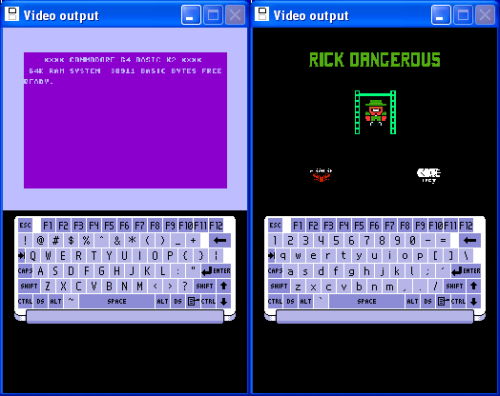
Hes also posted some more screenshots and WIP news, head on over to http://gpf.dcemu.co.uk for the Full info (post some comments too  ) )
To read more of the post and Download, click here!
 Join In and Discuss Here Join In and Discuss Here
Submit News and Releases Here and Contact Us for Reviews and Advertising Here |
|
 |
|
|
|
September 14th, 2005, 21:04 Posted By: wraggster
Nintendo Australia is excited to announce a new price point for Nintendo DS™ of $179.95 SRP.
The price drop will take place on September 22nd, just in time for the launch of the widely anticipated Nintendogs™. Nintendogs, which is now a cultural phenomenon in Japan, has just launched in the United States with sales of a quarter of a million units in its first week. This makes it America's hottest-selling video game and the best-selling new game franchise ever for a portable system.
“This is an exciting move for the already popular Nintendo DS, particularly aimed at making the unit more affordable and accessible to the new audiences we hope to be opening up with the release of Nintendogs” said Rose Lappin, Director of Sales and Marketing. “The new price point of $179.95 coincides with the launch of two new hardware colours of Cosmic Blue and Mystic Pink. Add to this the amazing new experiences with Nintendogs at the fantastic price of $49.95, making September 22nd a very big day for the Nintendo DS.”
With an onslaught of brilliant games coming for the rest of the year, there is something for everyone on the Nintendo DS. October 6th sees the release of the very unique Kirby™: Canvas Curse, and for the hardcore audience, the critically acclaimed Advance Wars®: Dual Strike. A new Pac Man adventure, Pac’n Roll™ is due November 3rd. The popular Mario Kart® series returns in November with Mario Kart® DS. Nintendo will also be releasing Meteos™ and Metroid® Prime Pinball in December. Metroid Prime Pinball will come bundled with the new DS Rumble Pak accessory that lets players feel all the rolling, bumping and tilting motions.
With around 30 new titles by the end of the year from other video game distributors, including King Kong: The Official Game of the Movie from Ubisoft, this promises to be an exciting holiday period for all Nintendo DS owners.
To read more of the post and Download, click here!
 Join In and Discuss Here Join In and Discuss Here
Submit News and Releases Here and Contact Us for Reviews and Advertising Here |
|
 |
|
|
« prev
1752
1753
1754
1755
1756
1757
1758
1759
1760
1761
1762
1763
1764
1765
1766
1767
1768
1769
1770
1771
1772
next » |
|
|
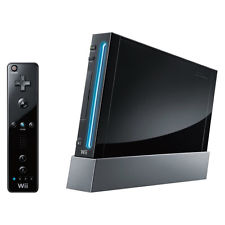 NES
NES